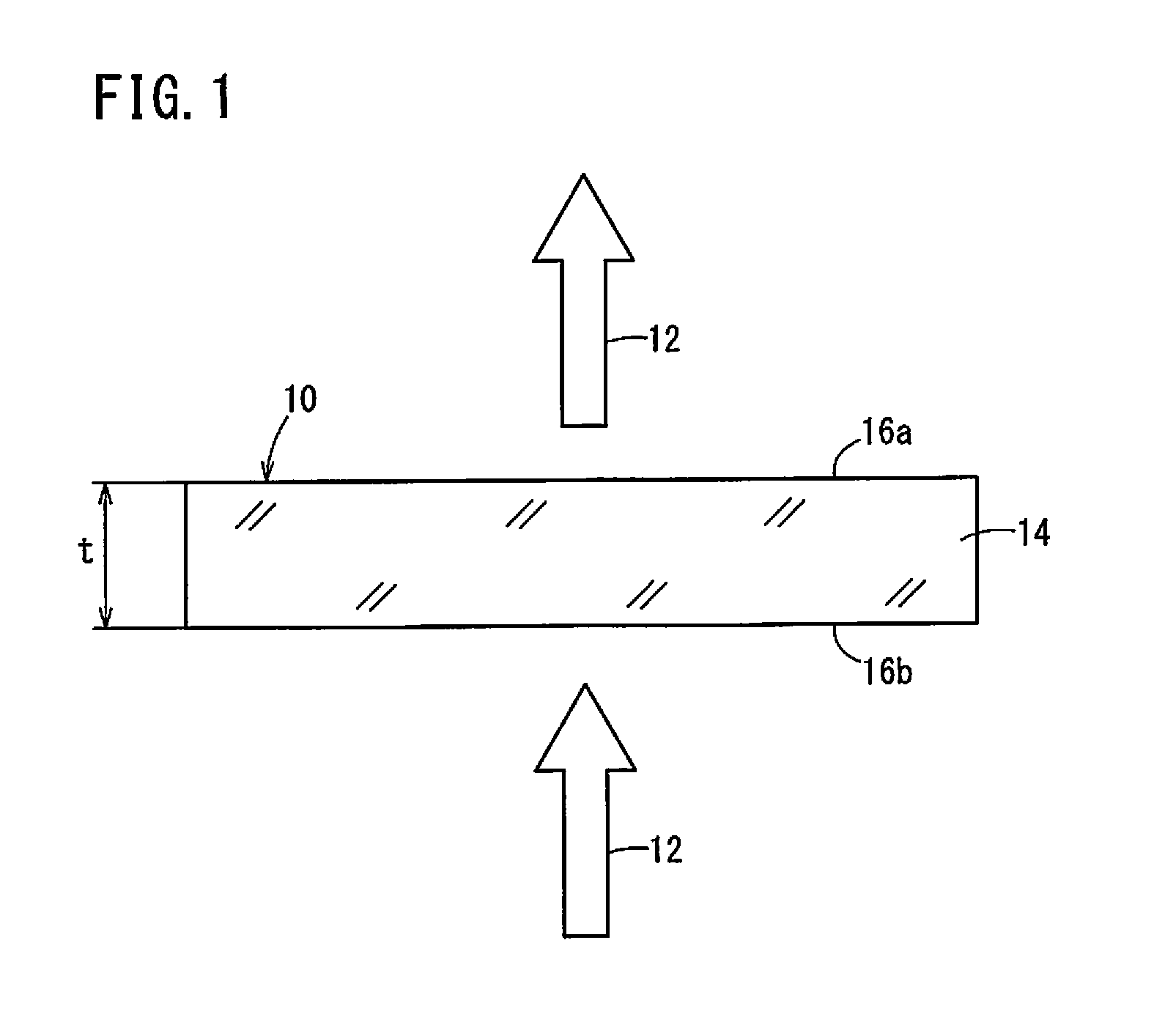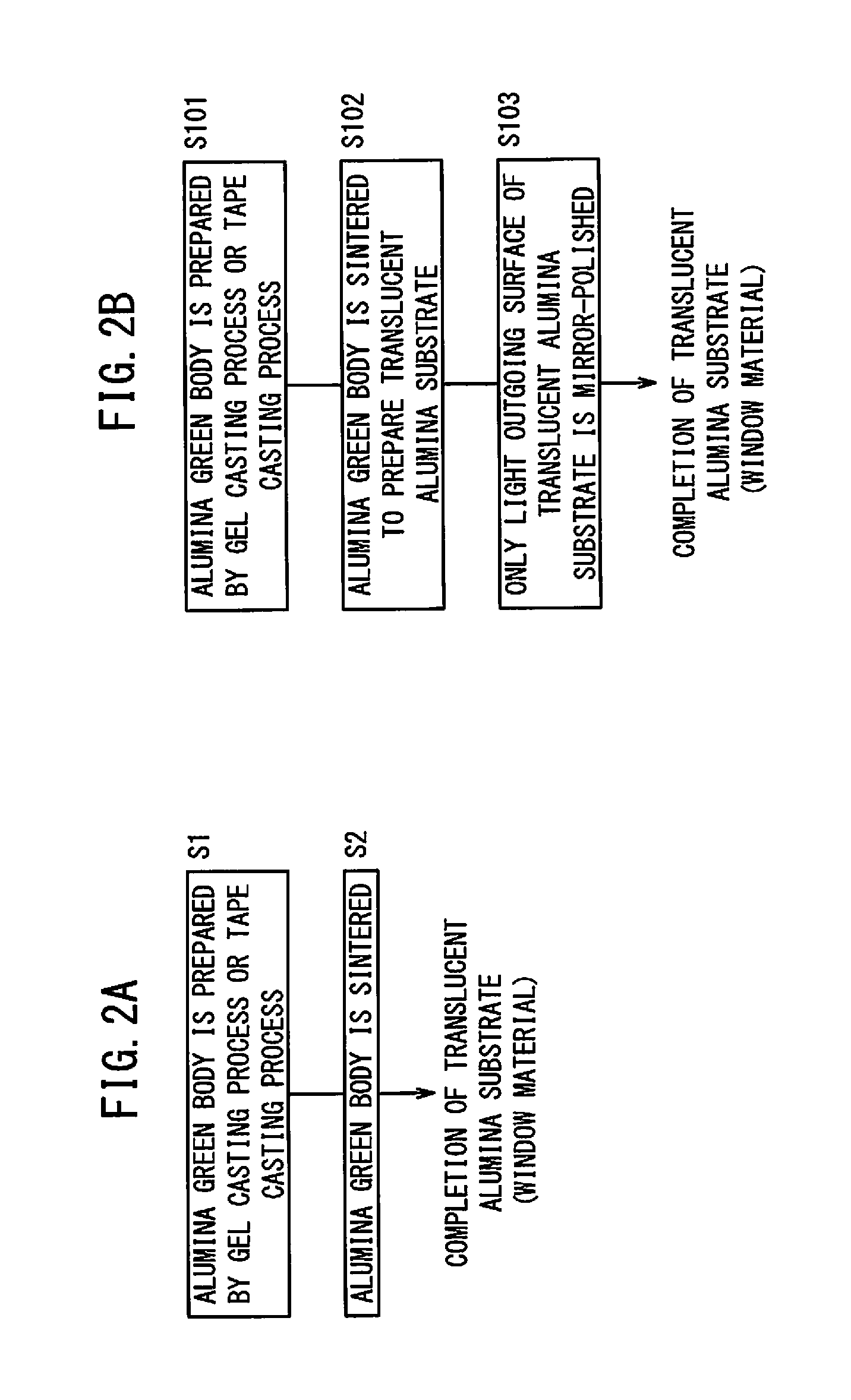Window material for ultraviolet-ray-emitting element and method for producing same
a technology of ultraviolet light and window material, which is applied in the field of window material for can solve the problems of low thermal conductivity of approximately 1 w/mk, inability to efficiently release device heat, and high temperature of ultraviolet light emitting devices using quartz, and achieves increased surface roughness of the other surface, increased surface roughness, and increased surface roughness.
- Summary
- Abstract
- Description
- Claims
- Application Information
AI Technical Summary
Benefits of technology
Problems solved by technology
Method used
Image
Examples
example 1
[0076]According to the first production method shown in FIG. 2A, a slurry containing a ceramic powder, a dispersion medium, and a gelling agent was cast into a mold. The slurry was converted to a gel to prepare an alumina green body, and the alumina green body was sintered to obtain a translucent alumina substrate 14 of Example 1.
[0077]Specifically, 500 ppm of a magnesium oxide powder was added to a high-purity alumina powder having a purity of 99.99% or more, a BET surface area of 9 to 15 m2 / g, and a tap density of 0.9 to 1.0 g / cm2. The starting material powder was formed by a gel casting process. 100 parts by weight of this powder, 40 parts by weight of a dispersion medium (dimethyl malonate), 8 parts by weight of a gelling agent (modified 4,4′-diphenylmethane diisocyanate), 0.1 to 0.3 parts by weight of a reaction catalyst (triethylamine), and a nonionic dispersing agent were mixed.
[0078]The slurry was prepared at 20° C. by the steps of dispersing the starting material powder and...
example 2
[0081]A translucent alumina substrate 14 of Example 2 was produced in the same manner as Example 1 except that the average grain diameter of the alumina powder (or the sintering temperature or the sintering time) was changed. The translucent alumina substrate 14 had a thickness t of 0.3 mm and had a surface with an average grain diameter of 12 μm. Both of the light outgoing surface 16a and the light entering surface 16b had the same surface roughness Ra of 0.2 μm. The front total light transmittance of the translucent alumina substrate 14 was measured. As a result, the translucent alumina substrate 14 exhibited an average transmittance of 90% in the wavelength region of 200 to 280 nm, and exhibited a transmittance of 95% at a wavelength of 210 nm.
example 3
[0082]According to the second production method shown in FIG. 2B, a translucent alumina substrate 14 of Example 3 was produced. First, a translucent alumina substrate 14 having a thickness of 0.5 mm was prepared in the same manner as Example 1. Then, only the light outgoing surface 16a of the translucent alumina substrate 14 was mirror-polished to produce the translucent alumina substrate 14 of Example 3 having a thickness of 0.3 mm. Before the mirror polishing, the surface of the translucent alumina substrate 14 had an average grain diameter of 20 μm, and both of the light outgoing surface 16a and the light entering surface 16b had the same surface roughness Ra of 0.3 μm. After the mirror polishing, the light outgoing surface 16a of the translucent alumina substrate 14 had a surface roughness Ra of 0.03 μm. The front total light transmittance of the translucent alumina substrate 14 was measured. As a result, the translucent alumina substrate 14 exhibited an average transmittance of...
PUM
| Property | Measurement | Unit |
|---|---|---|
| wavelength | aaaaa | aaaaa |
| grain diameter | aaaaa | aaaaa |
| surface roughness | aaaaa | aaaaa |
Abstract
Description
Claims
Application Information
 Login to View More
Login to View More - R&D
- Intellectual Property
- Life Sciences
- Materials
- Tech Scout
- Unparalleled Data Quality
- Higher Quality Content
- 60% Fewer Hallucinations
Browse by: Latest US Patents, China's latest patents, Technical Efficacy Thesaurus, Application Domain, Technology Topic, Popular Technical Reports.
© 2025 PatSnap. All rights reserved.Legal|Privacy policy|Modern Slavery Act Transparency Statement|Sitemap|About US| Contact US: help@patsnap.com



